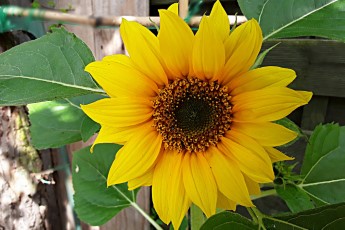There is so much more than meets the eye to a sunflower. I take them for granted as they brighten up my summer days and put a smile on my face. For thousands of generations, they’ve been in our lives not only as food, but they’re also steeped in history and have an important part to play in our ecosystem.
So What is Helianthus Annuus? It is the common sunflower. A crop that has been domesticated for gardens and also grows wild. It has medical and health uses. Food and beauty products are made from them. Religions and modern culture use it as their symbol of choice. And there’s so much more. Everything about the sunflower is here.
Whether you have a specific question or two about Sunflowers, or you want to know the full details you’ll find it here. This article provides an outline of all aspects that are sunflower related. For additional information on most areas, there’s an accompanying article within each section, which you can click on to get more detailed information. So here we go…
Table of Contents
What Does Helianthus Annuus Mean?
Helianthus annuus is the scientific name given to the plant we know as an annual sunflower. They are Greek words and translated they mean annual sunflower. Helios means sun, Anthus means flower and annuus means annual. Here’s how to pronounce Helianthus Annuus.
Most sunflowers are annuals. This means they grow for one season, then produce seeds that grow the following year.
Hellianthus Annuus, or Common Sunflower falls into the following categorization:-
- Kingdom Plantae – Plants
- Subkingdom Tracheobionta – Vascular plants
- Superdivision Spermatophyta – Seed plants
- Division Magnoliophyta – Flowering plants
- Class Magnoliopsida – Dicotyledons
- Subclass Asteridae – Meaning Daisy
- Order Asterales
- Family Asteraceae – Aster family
- Genus Helianthus L. – Sunflower
This may look very sciencey, but basically, this means –
- Sunflowers are of the plant kingdom.
- They have an internal system that moves food around the plant.
- They produce seeds
- They are a flowering plant
- They belong to the daisy family
- Their botanical name is Helianthus
- We call them Sunflowers
General Information About Sunflowers
Why Are They Called Sunflowers?
Sunflowers are so-called from the Greek word, and their scientific name, Helianthus. Helio means sun and Anthus means flower. This is because they look like the sun and their young buds and blooms follow the sun too. This is called heliotropism. Heliotropism translated is sun turning. Helio means sun and tropism means turning.
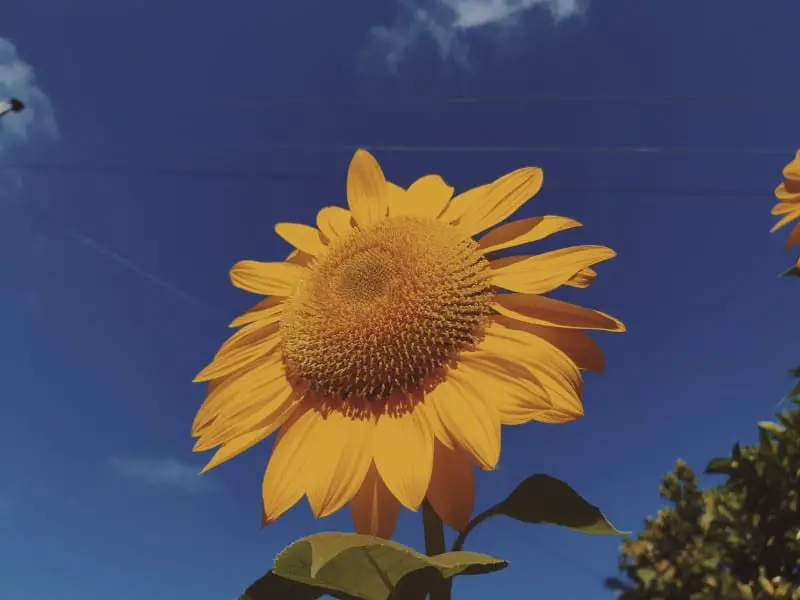
What Are the Characteristics of Sunflowers?
Most Sunflowers look like how we perceive the sun. A big round, warm yellow disc, that rays of warm yellow light extend from. Most sunflowers have these characteristics, a dark center disc, and rays of yellow petals.
But there are many varieties, colors, and sizes that sunflowers come in too.
There are small sunflowers called dwarf. Dwarf varieties often only grow up to 4 feet tall. Taller sunflowers, often referred to as a giant, grow up to and beyond 17 feet tall. Colored sunflowers are dwarf and giant varieties, and come in a multitude of colors such as red, orange, pink, and purple.
All these sunflowers can have blooms that are large and small. They can be single or multi-stemmed and have many flowers on one plant.
Most sunflowers have dark green, cordate or heart-shaped leaves. There are a few sunflowers that have long wedged or cuneate shaped leaves. I’ve also found a sunflower called Berkheya, that has spikey, thistle-like leaves, it has many small, pale purple flowers, and is a dwarf that only grows up to 12 inches high.
I’ve written all about 31 of the most wonderful sunflowers, the varieties, characteristics, and the colors are amazing. I hope you enjoy reading about them, and maybe finding a sunflower that you’d like to grow.
Sunflowers are grown commercially, as a crop for their oils and seeds. These are manufactured into food, health and beauty products. They are also used for medicinal purposes. And certain varieties are grown to feed birds, wildlife, pets, and livestock.
History of Sunflowers
The sunflower as a wildflower has existed for thousands of years in the wild. But in terms of popularity, we can safely say the sunflower first became popular in the southeastern United States. There’s sufficient evidence of sunflowers being grown and domesticated around 5000 years ago (circa 1600 BC) in Mexico, commonly cultivated by the Aztecs and the Otomi Tribes of Mexico.
Within a few hundred years, this domestication spread to southern parts of what is now North America, namely Tennessee and Kentucky (circa 2300 BC), where native Americans cultivated sunflowers for symbolism to Deities, as well as for other purposes such as herbal uses and medicinal remedies.
Skip forward many generations to around 1510 when the Europeans infiltrated both the North and South American Tribes and we begin to expand the modern world use of the plant entirely. Seeds were inevitably taken back to Europe, predominantly by Spanish ships and to this day, the sunflower is one of the four most important plant exports to Europe according to an investigative article by pnas.org.
I’ve listed here, sunflowers and the other plants from Eastern North American contributions, however, the Sunflower is seen as the most economically important of the four.
- Sunflower (Helianthus Annuus)
- Marsh Elder (Iva annua)
- Chenopod (Chenopodium berlandieri)
- Squash (Cucurbita pepo)
Cultivation continued for around 300 years and was accelerated in the 1800s when exported to Russia by members of the Russian Orthodox Church. Strangely this is where Sunflowers then develop a link to Lent as Sunflower Oil was permitted during Lent as part of the fasting tradition. So, cultivation began in Russia in a village called Alexeyevka by a merchant named Daniil Bokaryov.
Not only did Daniil Bokaryov cultivate the plant, but he developed a special technology for mass production and harvesting of Sunflowers and extraction of Sunflower oils. To this day the town still has a sunflower upon its coat of arms, to mark its legacy of the beginning of Sunflower production in Russia.
I’ve expanded on this in a later article dedicated to the History of Sunflowers in more detail. If this is something you’re studying at present, then I’d recommend reading it.
Anatomy of a Sunflower
Sunflower Roots
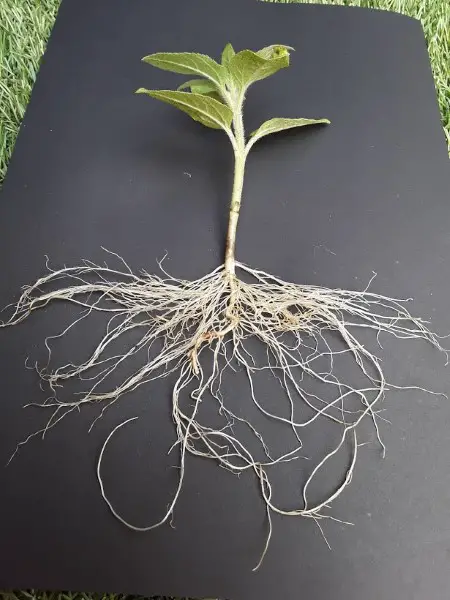
Sunflower roots vary for each different variety. Obviously, if the plant is tall then the roots grow deeper and longer, as opposed to the smaller varieties growing shallower and not so long. In general, whether the sunflower is tall or small, the root system is the same.
The roots of sunflowers have 2 parts to their root system. The first main root is called a Taproot and is singular, strong and long. This is the main part of the root. The secondary root is more fibrous and hairy looking and stems off from the Taproot. They can grow from 1 to 3 feet in depth.
Sunflower Stem/Stalk
Sunflower Stalks vary in thickness and length, depending on the variety that they are. Some varieties of sunflowers can grow up to, and beyond 17 feet. The dwarf varieties are more compact, but their stalk is made up the same.
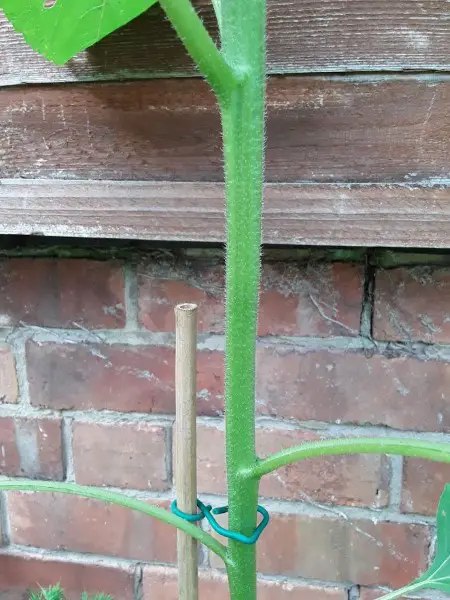
The sunflower stem is the next important part of the plant. The first being the roots. The stem is divided into two main parts called nodes and internodes. The nodes are where the leaves and buds develop from, and the internodes are the distance between each node, where nothing grows.
The stem keeps the leaves and flower upright and provides the sunflower with nutrients and water drawn up from the root system.
Sunflower Leaves
Sunflowers have leaves that are usually, dark green, large, and heart shaped. Some sunflower varieties have elongated leaves that are silvery green. Leaves have a very important job to do for a plant.
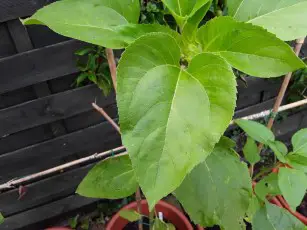
The main function of a sunflower leaf is to convert sunlight, nutrients, and water from the soil into energy for the plant. This is called photosynthesis.
Sunflower leaves are divided into these parts. The epidermis, which is the outer covering, or skin. The mesophyll which is the inner part of the leaf where photosynthesis happens, and the veins, the veins supply the water for photosynthesis.
The main function of a sunflower leaf is to convert sunlight, nutrients, and water from the soil into energy for the plant. This is called photosynthesis.
Sunflower leaves are divided into these parts. The epidermis, which is the outer covering, or skin. The mesophyll which is the inner part of the leaf where photosynthesis happens, and the veins, the veins supply the water for photosynthesis.
Some sunflower leaves, depending on the variety, have hairs on them. This could be for a number of reasons. Prickly sunflower leaves use them as a defense against pests, and to stop being eaten.
Sunflower Bud
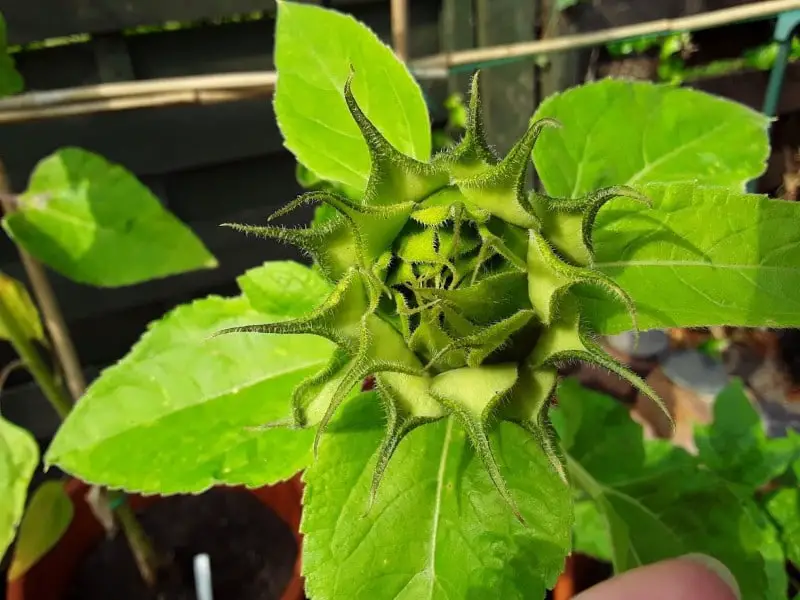
The sunflower bud is the early stage of a flower bloom. The bud follows the sun across the sky from east to west every day, this is called heliotropism. The reason it does this is so it can get as much energy from the sun to grow big and strong, in order to produce the biggest crop of seeds that it can.
Sunflower Bloom

When the sunflower bud has bloomed it has one main task in mind, to be pollinated and produce seeds. The sunflower bloom has bright yellow ray florets, also known as petals, and a large brown center disc, that can be made up of over 1,000 individual disc florets.
Each individual disc floret is a flower in itself and made up of six parts.
- Stigma
- Style
- Anther
- Corolla
- Ovary
- Ovula
The outer ray florets entice pollinators to the center disc, where pollination takes place through the six parts of each disc florets. When pollen is transferred onto the stigma it travels through these parts and a seed is reproduced in the ovule.
Sunflower Seeds
Sunflower seeds are made up of an outer shell called a husk and an inner softer part called a kernel. The husk protects the kernel from outside contamination and the kernel holds all the genetic information that is held dormant within the husk till it is planted.

The seed of a sunflower is the last stage of the plant’s life, and also it’s beginning. The seed holds all the genetic information, of its own characteristics, that it passes on to be grown in the following year.
How Sunflowers Breathe
Sunflowers do breathe, but not in the same way we do. They breathe through their stems, leaves, buds, and flowers. All these parts of the sunflower have tiny pores on them called stomates, through which they take in carbon dioxide and give out oxygen. This is very basically how they breathe. It’s such a fascinating and interesting subject that I’ve written an in-depth article about how sunflowers breathe here.
Varieties of Sunflowers
There are many varieties of sunflowers available. Here I’ve added a selection of some of the more popular and easy to grow varieties stretching across three sections. Tall, or giant Sunflowers, Dwarf Sunflowers, and Colorful Sunflowers.
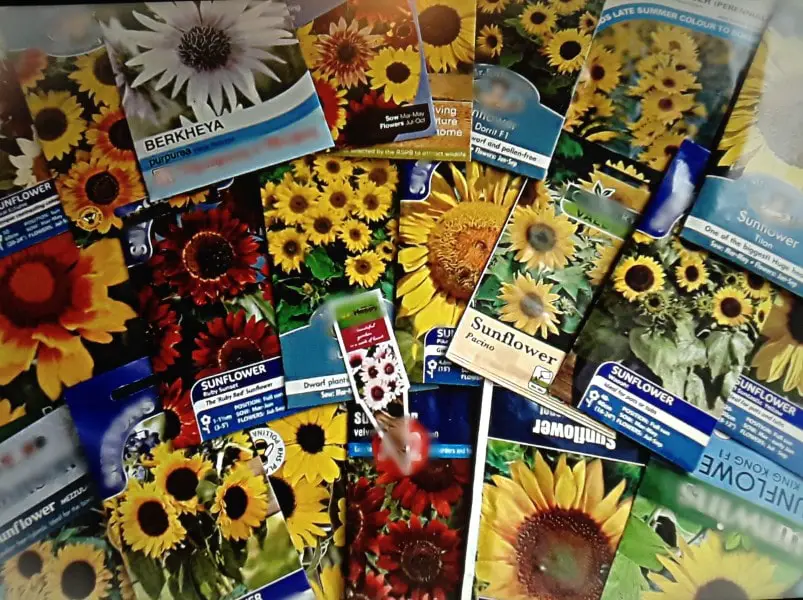
Click on each name below to go to my page all about that particular sunflower. Or you’ll find a link at the bottom of each section for more information on all of the varieties.
Colorful Sunflowers
| Sunflower Variety | Height | Bloom Size, Color | Stem Type, Bloom Qty |
| Evening Sun | 6’ | 4” Red, Bronze, Yellow | Single Stem, Multi-Bloom |
| Red Sun | 6; | 4” Dark Red | Single Stem, Multi Bloom |
| Ruby Sunset | 3’ – 5’ | 8” Red, Orange Hues | Single Stem, Multi Bloom |
| Velvet Queen | 6’ | 5” Claret, Copper | Multi Stem, Multi Bloom |
| Black Magic | 4’ | 8” Dark Maroon | Multi Stem, Multi Bloom |
| Mexican Orange | 3’ – 5’ | 2” – 3” Vibrant Orange | Multi Stem, Multi Bloom |
| Mexican Red | 3’ – 5’ | 2” – 3” Bright Red | Multi Stem, Multi Bloom |
| Italian White | 5’ | 4” Creamy White | Multi Stem, Multi Bloom |
| Pink Landum | 3’ – 5’ | 4” – 6” Pink | Single Stem, Single Bloom |
| Pale Purple Berkheya | 1’ | 4” Pale Purple/Violet | Multi Stem, Multi Bloom |
| Ms Mars | 1’ – 2’ | 4” Purple, Pink Hues | Single Stem, Multi Bloom |
For a better guide, you can see an image of these next to each other on my other article on colorful sunflowers This guide will really help you choose which varieties you want to grow.
Traditional Tall Sunflowers
Click on each name below to go to my page all about that particular sunflower. Or you’ll find a link at the bottom of each section for more information on all of the varieties.
| Sunflower Variety | Height | Bloom Size, Color | Stem Type, Bloom Qty |
| Giraffe | 17’ | 17” Yellow | Single Stem, Single Bloom |
| Pikes Peak | 15’ | 15” Yellow | Single Stem, Single Bloom |
| American Giant | 14’ | 12” Yellow | Single Stem, Single Bloom |
| King Kong | 14’ | 6” Yellow | Multi Stem, Multi Bloom |
| Titan | 10’ | 24” Yellow | Single Stem, Single Bloom |
| Russian Giant | 6’ | 12” Yellow | Single Stem, Single Bloom |
| Giant Single | 6’ | 8” Yellow | Single Stem, Single Bloom |
| Maximilian Prairie | 5’ – 8’ | 5” Yellow | Multi Stem, Multi Bloom |
| Alchemy | 5’ | 6” Yellow | Multi Stem, Multi Bloom |
| Hallo | 4’ | 8” Yellow | Multi Stem, Multi Bloom |
For a better guide, you can see an image of these next to each other on my other article on tall sunflowers. This guide will really help you choose which varieties you want to grow.
Dwarf Sunflowers
Click on each name below to go to my page all about that particular sunflower. Or you’ll find a link at the bottom of each section for more information on all of the varieties.
| Sunflower Variety | Height | Bloom Size, Color | Stem Type, Bloom Qty |
| Sunbright | 3’ – 5’ | 4” – 6” Yellow | Single Stem, Single Bloom |
| Gaillardia | 12” – 16” | 3” Yellow | Multi Stem, Multi Bloom |
| Mezzulah | 3’ | 8” Yellow, Orange Hues | Single Stem, Single Bloom |
| Teddy Bear | 2’ | 4” – 5” Yellow, Orange | Multi Stem, Multi Bloom |
| Little Dorrit | 2’ | 4” Yellow | Multi Stem, Multi Bloom |
| Pacino Gold | 2’ | 5” Yellow | Single Stem, Single Bloom |
| Sunspot | 2’ | 10” Yellow | Single Stem, Single Bloom |
| Waooh | 3’ | 4” Yellow | Multi Stem, Multi Bloom |
For a better guide, you can see an image of these next to each other on my other article dwarf sunflowers. This guide will really help you choose which varieties you want to grow.
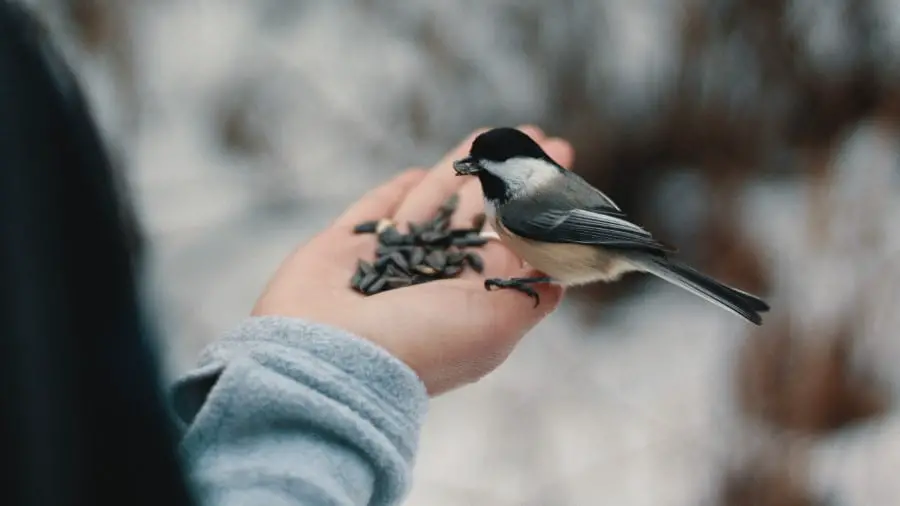
Varieties of Sunflower Seeds Used for Wild birds, Livestock and Pet Foods
There are two main varieties of sunflower seeds that are used for wild birds, livestock and pet food. These are the Peredovik Black Oil Sunflower and the Giant Grey Striped Sunflower.
Peredovik Black Oil Sunflower seeds are high in fat content.
This makes them ideal for all wild birds, as it gives them a lot of energy and nutrition in one small swoop. These sunflowers grow about 6 feet tall and produce a large amount of seed crop.
If you like to attract wild birds to your feeders, and can’t find these seeds locally, I’ve found quality Black Peredovik seeds on Etsy for you.
The giant grey sunflower seeds are not as high in oil content, but still nutritionally bountiful. These seeds come from a giant sunflower with a large yellow bloom, which produces thousands of seeds. Inside the shell is a large, chunky kernel, they are easily opened by small birds and animals.
Growing Sunflowers
Depending on the variety, what part of the world you live in and the climate conditions, Sunflowers are fairly easy to grow.
How to Grow Sunflowers
I’ve written an easy to follow, and an in-depth guide about how to grow sunflowers and a sunflower variety guide, with height charts and a global guide of when to sow, plant and harvest, so choosing the best sunflowers for your circumstances is easy. Whether you have one pot, a yard or a field.
Some of which involves the following…
- Choose the seeds you desire
- Use a multipurpose compost to plant the seeds
- Sow your seeds in pots that have good drainage
- Follow the instructions on the packet for how deep to sow the seeds, and what time of year to sow them. If you’ve been given seeds without the packet, follow my seed sowing depth guide here
- Water regularly and don’t let the compost dry out.
- When the seedlings appear, thin them out as required.
- Harden the seedlings off before planting them in their growing site you have prepared.
- Nurture and protect the young sunflowers, if needed, give them support.
- And finally, enjoy your sunflowers.
Timeline and Growth Cycle of a Sunflower
A tall, giant-headed, annual sunflower seed sown in the middle of spring, generally takes all summer to grow and usually blooms at the end of summer. The bloom can last for a few weeks. So from planting the seed to being in full bloom, it takes about 125 days.
The multi-headed dwarf varieties of sunflowers start blooming earlier and can bloom throughout the summer.
There are 8 stages of an annual sunflowers growth timeline, of which I have written about in more detail on this article the life cycle of a sunflower. What follows is a basic outline.
- The seed is planted.
- Germination
- Plant development
- Bud growth
- Flowering for pollination
- Seed development
- Harvesting

Bees are amongst many insects and creatures attracted to sunflowers. Hummingbirds and, amazingly, bats are pollinators too, and If you are lucky enough to live where hummingbirds dwell then the vibrant Mexican sunflower ‘orange and ‘red are the best sunflowers to grow that attract them.
Sunflower Problems and Solutions
Sunflowers can be tasty to many a critter. These creatures can munch on sunflowers till their heart’s content. And in doing so can cause infestations, diseases or totally destroy a plant in one sitting, or throughout its lifecycle.
Diseases, Pests – Problems and Solutions
Please don’t let sunflower problems put you off from growing sunflowers. The world and its creatures need them. Once you know what to look out for, and how to control pests and nip diseases in the bud, you can sit and enjoy your beautiful blooms.
In general, sunflowers are very hardy plants that can put up with most problems, but some of the problems can be quite annoying. And if not dealt with can cause the loss of your plants.
I’ve gathered together the common problems that I get asked about the most. I hope you find the answers helpful.
Sunflower Root – Problems and Solutions
| problem | cause | solution |
| Root Bound. The roots of my sunflower plant are poking through the bottom of the pot and in a tight root ball in the pot. | The sunflower plant has Outgrown its pot. It needs more room to grow. | Needs potting into a bigger pot, or planting out. Gently ease sunflowers out of pots. Tease roots carefully, and plant on. |
| Waterlogged roots. My sunflowers are sitting in a puddle of water in their pots and around the plants outside. The roots and stems are going brown. | Bad drainage in pots or ground. These cause build-up of water that doesn’t drain away and can cause root and stem rot. | Put drainage material at the bottom of pots and underneath plants in the ground. Prepare planting site in advance to rectify drainage problems. |
| Rotting roots. Why are my sunflower roots Rotting? | Various rotting diseases. Fungi forming at ground level due to Bad growing conditions or poorly drained soil. | Detected early will stop the spread. Dig up and discard the plants. Introduce good drainage material in the growing area. |
| Cutworm. Why are my young sunflowers Dying back, getting loose at the roots and the roots look eaten? | Cutworms. These are larvae from different moths. They eat and cut through the plant at the base. | Carefully dig out, and discard the plant. This will prevent the cutworms from wriggling onto the next sunflower |
Sunflower Seedling – Problems and Solutions
| Problem | Cause | Solution |
| Seedlings being eaten. My sunflower seedlings are being eaten? | Slugs, snails, caterpillars and some birds find newly sprouted seedlings to be very tasty. | Use gritty gravel, eggshell, grease or copper bands that prevent slug attacks. Pick caterpillars off plant leaves and discard. Cover seedlings with crop protection mesh to prevent birds from having a picnic. |
| Frostbitten seedlings. Why have my newly planted out seedlings died? | Frost is still a threat until the end of spring. | Don’t plant out sunflower seedlings too early. Harden them off in last two weeks of spring. When there’s no more threat of frost plant them out. |
| Poor emergence. My sunflower seedlings have popped through the soil and the leaves are yellow, stunted and deformed | The seeds may have been affected by poor storage or chemical damage. | Unfortunately, these seedlings need to be discarded. Plant seeds free from pollutants have been stored carefully or from a reputable seed seller. |
| Leggy, weak, drooping seedlings. | Planting indoors too early. Some varieties are naturally like this, don’t panic. | Support seedlings with popsicle sticks or small plant canes. Be gentle and patient, until its time to harden off, and plant them outside. |
| Seeds aren’t growing. Why aren’t my sunflower seedlings coming up? | Seeds may be planted too deep. The soil may be too cold or waterlogged. Seeds saved from F1 plants may not be bred for germination. Critters may have dug them up and eaten them. | Plant at the right time of year at the right depth in well-drained pots or ground. Protect seeds planted with netting or wire mesh. |
Sunflower Stem – Problems and Solutions
| Problem | Cause | Solution |
| Rotting stems. The stems of my sunflower look brown/black and are soft. Some of my plants have bent and collapsed at the rotted area. | This is a bacterial sunflower stalk rot. Usually found in corn or other tall, thick-stemmed crops. Waterlogged and high irrigation areas are mainly the cause. | Avoid overwatering and don’t leave them sitting in puddles of water outside. Introduce good drainage material into pots, or the ground before planting out. |
| Cuckoo spit. I’m finding frothy white foam that’s a bit sticky on all parts of my sunflower | This froth contains a bug called a froghopper. They appear in the late summer and aren’t harmful to a mature sunflower. | Brush the froth away with your hands or wash it away with water from a hose, or gently use a sponge and water. |
| Stem Damage. Some of my sunflower stems look like they’ve been chomped and chewed on. | Squirrels and rodents sometimes get a taste for juicy stems. | Spray with a solution of water and cayenne pepper and a few drops of dishwashing liquid. To deter them. |
| Bending stems. Sunflower Stems bend and can crack or fall over. | High winds and heavy rain can batter even the strongest of sunflowers. Heavy blooms can cause bendy stems too. | Stake sunflowers to support whilst they are growing. Use rubber coated wire or soft cord to tie them up. Don’t tie too tight |
Sunflower Leaves – Problems and Solutions
| Problem | Cause | Solution |
| Aphids. My sunflowers are crawling with little green and black flies. There’s so many of them. They’re distorting my sunflower. | Aphids, come in many varieties and reproduce in great quantity. They are sticky, and large infestations cause plant distortions and spread other viruses. | When aphids are spotted, use a mild solution of washing up detergent and lots of water to sponge them away. Companion planting will attract good bugs to sort the problem out for you. |
| Sunflower Leaf Rust. There are little rust colored spots on my sunflower leaves. Some of the leaves are dying back. | The look of leaf rust can vary and if it’s not too bad, or has been going on too long, then the plant may still flower. | Space your sunflowers out according to their growing size. They need room for air circulation. Discard any fallen infected leaves. |
| Sunflowers and caterpillars. Help! My sunflower leaves are being eaten at a fantastic rate. | If you’ve ruled out slugs and snails, then it could be both moth and butterfly caterpillars of many varieties. | Stop sap munching caterpillars by covering your sunflower plants with fine fleece. This will prevent further egg laying. |
| Leaf Miners. I see little white, squiggly fine line patterns inside my sunflower leaves. | There are many leaf miners, usually the larvae of moths, flies, and beetles. They eat and live within the leaf tissue. | A problem that is more cosmetic than a danger to the plant. A fine fleece will prevent further eggs from being laid. |
| Grey Mould. My sunflower leaves were brown and yellow, then this grey, white-fuzzy mold appeared. What to do? | The brown and yellowing leaves are Damaged. Without help, this has developed into a grey mold. This may destroy your plant. | To prevent this, give your sunflowers the room they require when you plant them. Remove damaged leaves and discard to prevent further infection. |
Sunflower Bud – Problems and Solutions
| Problem | Cause | Solution |
| Aphid bud Infestation. The buds of sunflowers can be crawling with green and black aphids. They distort and stop the flower blooming. | Aphids, come in many varieties and reproduce in great quantities. Large infestations on the sunflower bud can cause distortions and spread of other viruses. | As aphids are spotted, use a mild solution of washing up detergent and lots of water and sponge away. Try Companion planting. To attract good bugs to help you sort out the problem naturally. |
| No Sunflower Bud? Here are a few reasons why. | Not enough sun. Overfeeding can cause plants to grow too much foliage and have no energy left to grow a bud. Or the top of the stem may have been eaten by wildlife. | Plant in the sunniest place possible. Water often and, if soil quality is poor, feed once a week. Protect your forming buds from critters with mesh or netting. |
| Earwigs. Earwigs are another bug that likes to eat sunflowers. | Earwigs are a long, brown shiny insect. Usually coming out at night to feast on plants and garden debris. | Earwigs don’t usually fly, they crawl up a plant. For big infestation, put petroleum jelly on the bottom of the stem to deter them. |
| Unequal Bud development. Why do some sunflowers bloom at different times? | Not all plants may be at the same stage of growth. Be patient. They usually bloom within a week or so of each other. | Different Planting positions may give some sunflowers more time in the sun than another. Different varieties bloom at different times. |
Sunflower Bloom – Problems and Solutions
| Problem | Cause | Solution |
| Wilting sunflower head. Why is my sunflower bloom starting droopy and wilting in its prime? | Lack of water or waterlogged. | Check the ground isn’t too dry if so, give more water. If there’s a puddle of water, hold off from watering, help drainage by pricking the ground. |
| Why do sunflower blooms start to bend over, sag and go yellowy brown? | Sunflowers get heavier as they mature. They can produce thousands of seeds which get heavy and cause the bloom to sag. | This is natural with big bloomed sunflowers. As the seeds fall l gather some for myself and let nature take the rest. |
| Why aren’t my sunflower blooms as big as I expected | Not been spaced out enough. Lack of sunlight. Lack of nutrients. | Sunflowers need room to grow. Plant them 2 feet apart in the sunniest place you can find. Feed them once a week. |
| Why isn’t my sunflower blooming? There’s a bud and it hasn’t opened. | Not enough sunlight or too much rich soil feeding and creating more foliage. | Be patient. It may still open and surprise you. If not, Try a different planting area next year. |
| Late and uneven flowering. The same variety of sunflowers, planted at the same time can bloom days or a week apart from each other | Slightly different growing conditions. Lack of sunlight or development hasn’t quite caught up with each other. The original sunflower seeds may be of different quality to each other. | Be patient. If the plant is healthy there is a good chance it will flower. |
| Different sunflower blooms than last year. I grew this year’s sunflowers from the seeds saved from last years harvest. Why are the flowers a different color, and size? | Cross-pollination with other varieties of sunflowers nearby. | Grow all the same sunflowers. Although pollinators can come in from neighboring gardens. Buy the same seeds that you like and grow them again. In the meantime enjoy the unique sunflowers you have created. |
Sunflower Seeds – Problems and Solutions
| Problem | Cause | Solution |
| Why are there no seeds on my sunflower? | You may have planted a seedless variety. No pollinators visiting. Or. Wildlife may have got there first. | Choose a variety that you can expect seeds to grow from. Allow access for your sunflowers to have visiting pollinators. Protect your sunflowers from wildlife. |
| Why do my sunflowers have empty Seeds shells? | There may be an infestation of Sunflower Moth. the moth larvae bore into the young seeds and feast on them. | To prevent infestation of sunflower moths use insecticides. Take care not to harm other pollinators. |
Top Tip. I always plant many more sunflowers that I need. This allows for any problems that may cause a loss to my plants. If I end up with too many healthy ones, which is always a nice problem to have, I gift them to family, friends, and neighbors.
Sunflower Pollination
It’s an interesting subject when it comes to pollination in sunflowers. Sunflowers pollinate in 3 different ways. Pollination by agents, cross-pollination, and self-pollination.
The most fascinating one is self-pollination. this is all to do with the mechanism that the sunflower has evolved over thousands of generations to ensure its survival. I’ve written all about these pollination techniques here, in more detail.
A giant sunflower center disc can have up to, and over, a thousand disc florets. If each of these disc florets is pollinated it has the potential of producing a seed. Bees are the main agents of pollination in sunflowers, and this is how they go about pollinating.
- Bees visit a sunflower for the nectar, and pollen gets stuck on his furry body and legs.
- He then visits another sunflower and transfers the pollen to the stigma of the sunflower.
- The pollen particles get processed down the stigma, style, anther, Corolla, ovary, and end up in the ovule where the germination of the seed begins.
- The seed contains all the genetic information to grow another sunflower the following year.
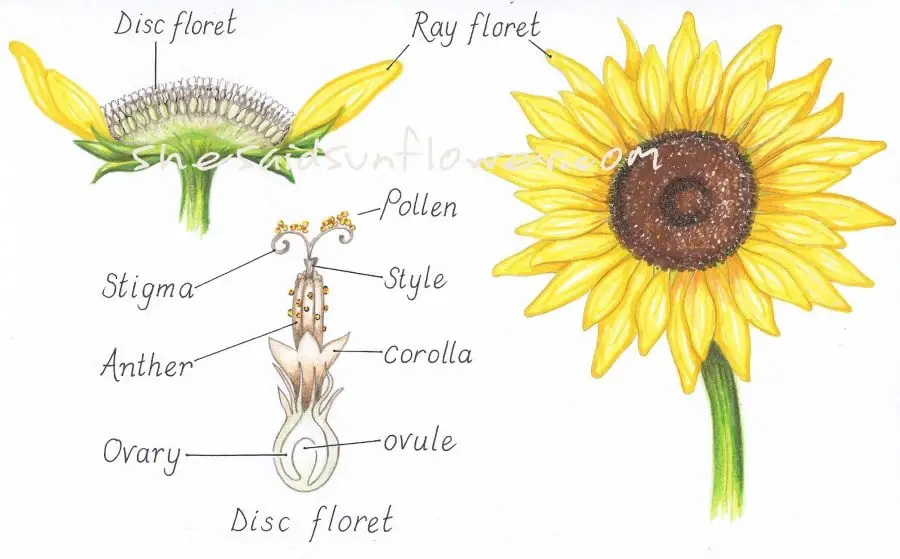
Heliotropism
A little known word perhaps, but one you may be familiar with by sight. The act of Heliotropism is one undertaken by growing sunflowers. Due to the fast growth rate of sunflowers, they need as much sunlight as they can get in order to grow strong and tall, and the more sunshine they can obtain for growth, the greater yield of seeds they will tend to have.
In order to obtain as much sunshine as possible, sunflowers have growth hormones that create a mechanism that enables them to follow the sun, in doing so, the head of the sunflower can absorb more sunlight and convert that energy by means of photosynthesis.
Harvesting
When the sunflower has fully bloomed and been pollinated, the seeds start to form. The petals start to fade and the back of the sunflower head begins to lose its lush green color and turn yellow and brown. This is an indication that the bloom is drying out, and the seeds are ready to harvest.
How to Harvest Sunflowers by Hand
One method of harvesting by hand is to wait until the seeds are fully ripened whilst still on the stem of the plant. As the seeds start to loosen and fall out naturally, cut the stem about two inches below the bloom. Briskly rub your hands over the seeds to get them out. Let the seeds dry out further before storing them.
Another method of harvesting by hand is to five to six inches of stem, below the bloom, when just over half the seeds are ripe. Wrap a paper bag around the whole head, turn upside down and hang it in a dry, ventilated place for a few weeks. The seeds will ripen and be caught in the bag.
How Sunflower Seeds are Harvested in Agriculture
At the end of summer, when sunflowers seeds have ripened. A combined harvester, that has been adapted, is driven through the fields to collect sunflower seeds. A thrashing unit separates the seeds from the head, leaves, and stem. This is then blown out of the back of the harvester as chaff.
The seeds are then sent off for processing. Some are used in food and bird feed. A percentage are crushed to make sunflower oil. The ‘meal’ that is left over from the crushing is turned into livestock feed. The oil is then sent to a refinery for further processing.
I’ve found this youtube video that shows sunflower harvesting in action
Dehulling and Processing Sunflower Seeds
The ‘dehuller’ is a machine that separates the shells from the sunflower kernel. The seeds are drawn into the machine and vibrated so they’re spread evenly. The dehuller mechanism presses onto the seeds and cracks the shells. The shells are shaken loose and blown away as chaff, leaving the heavier kernel behind.
The kernels are then mechanically batched together, before being sent to the production line, ready for processing. Sunflower kernels are incorporated into many products, such as snacks, cooking, roasting, and baking. They’re also used to produce oil. They’re used in wild bird and animal feed. Health and beauty products.
Sunflowers in Agriculture
Below is a graph based on research conducted by statista on worldwide Sunflower seed production 2018/2019 in million metric tons.
It’s not surprising that given the history of sunflower production in the Ukraine and Russia, that to this day production from this part of the world is still a major part of the entire world’s production of sunflower seeds. Other contributions come from the European Union, as well as Argentina, Turkey, the USA, and other Nations.
Image source: statista
Sunflowers are Grown to Protect Crops
Because helianthus annuus is inexpensive and easy to grow, they are used to protect more expensive crops. By planting sunflowers all the way around the cultivated plant that needs protecting, wildlife such as deer, munch on the sunflowers and leave the more expensive crop alone.
Normal Climate for Growing Sunflowers
Sunflowers don’t need the best weather or growing conditions, so long as there is a good amount of sunlight, a place for their roots to grow, a supply of water and good drainage will see them thrive. They’ll grow in gardens, yards, in the wild and open fields. And of course agriculturally as a crop.
Where Sunflowers Can’t Grow
Sunflowers can be very easy to grow but still have their limitations. They are vascular plants, meaning they can’t grow in, flowing water, lakes or saltwater. They don’t generally thrive in extreme climates such as snow, or in the middle of deserts.
Unusual Climates that Sunflowers Grow in
There are a few varieties of sunflowers that grow in unusual climates…
The Swamp Sunflower
The swamp sunflower can survive in, poor drainage areas for extended periods of time. They thrive in moist, clay-based soil. You can see them growing wild through much of the Eastern United States, in ditches. Swamp sunflowers can reach up 5 to 7 feet tall.
They are lesser known but nonetheless a lovely sunflower with multiple heads, easy to grow, ideal for cutting and putting in vases. I’ve written more details about swamp sunflowers here.
The Beach Sunflower
The beach sunflower grows in sandy, well-drained soil, and like all sunflowers, they need lots of sun. They are salt-tolerant and drought-resistant.
Beach sunflowers can be found in sand dunes amongst the vines and grasses. The root easily and grow up to 2 to 4 feet tall. They are multi-headed and have many uses. Again this is a lesser known variety so I’ve written more details about beach sunflowers here.
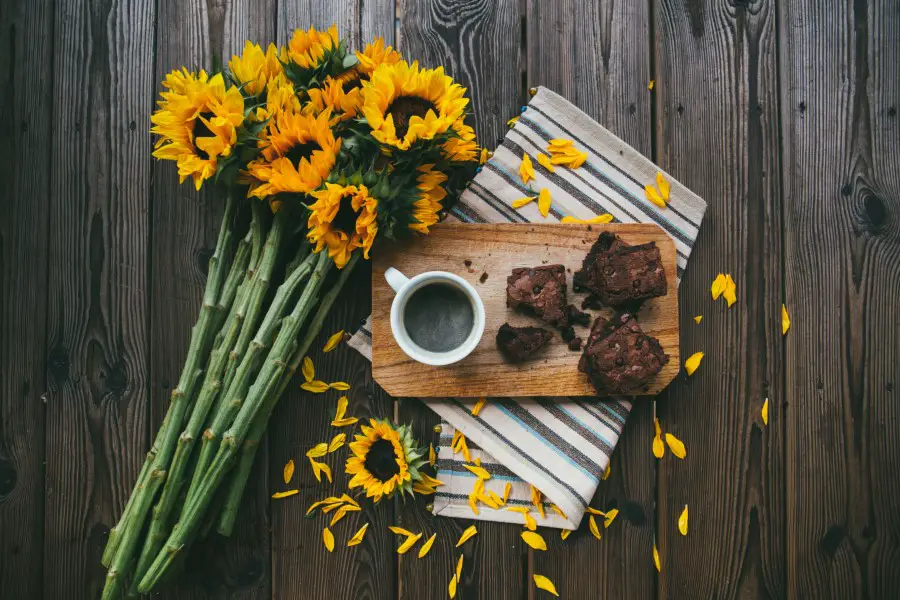
Sunflowers in Food
Like many plants, Sunflowers have been a source of food and nutrients for thousands of years. As a result – and certainly more so in modern times, the properties have been proven to have many beneficial ingredients.
Here’s a small selection of foods borne out of Sunflowers that are now widely available, and is the main reason why Sunflowers are grown in mass production within agriculture.
Sunflower Seeds
We’ve all seen the rows of sunflower seeds in the aisles of our local store. The health-giving qualities of sunflower seeds provide a number of natural substances which provide health and vitality to the body as well as essential vitamins and minerals. Here’s a quick rundown on the vitamins and minerals a sunflower seed contains…
- Essential fatty acids
- A variety of amino acids
- Vitamins A
- Vitamin B
- Vitamin C
- Vitamin E
- Calcium
- Iron
- Potassium
- Zinc
- Magnesium
- Manganese
- Selenium
With such a healthy list, is it any wonder their a sought after natural seed powerhouse. And unlike many other food types, because sunflowers seeds, by their nature, are designed to fuel the next generation of sunflowers, so it’s no wonder they’re packed with a powerhouse of Vitamins and Minerals.
And if you like your sunflower seeds, and you’re looking for an additional boost in flavor, then why not try a variation on the theme such as these Pit Smoked Ghost Pepper Flavored sunflower seeds!
Bird Seed
Different varieties of Sunflowers are grown for different reasons, some of the high seed yielding varieties are grown for their use in natural foods for pets and birds.
These are considered ‘lower grade’ sunflower seeds, manufactured in mass quantities, so they’re generally more suited for feeding wildlife.
However, I’ve created an entire video which explains how we can use these ‘Birdseed’ Sunflower seeds for growing fabulous Sunflowers in our gardens and communities. The video is about growing sunflowers on a budget or growing sunflowers as a group activity, be sure to check them out!
Sunflower Oil
The vast majority of sunflowers grown on a mass scale for agricultural are grown for their sunflower Oil properties, these have been a gradually increasing trend since the 1800s in Russia (see history above).
But in fact, Sunflower oil has accelerated in popularity over the past 10 years or more. This is mainly due to its origins of health providing ingredients and according to livestrong, when used in moderation, it can be very beneficial.
Sunflower Butter
In recent times Sunflower Butter has become extremely popular! Sometimes referred to as SunButter and is an alternative to Peanut butter that provides a nut-free alternative for many who suffer from peanut allergies. It’s also free from tree nuts, egg, gluten, dairy, and sesame. The taste is different from peanut butter – it tastes like Sunflowers – of course!
Halva
Pronounced Halva is a sweet treat, predominantly made and consumed in eastern European countries like Poland and Slovakia. A sugary treat often made to include sesame seeds but can also be made with sunflower seeds instead. I highly recommend trying it – but only as a treat, as it can contain its fair share of sugar!
Sunflowers in Culture, Arts, and Science
The Fibonacci sequence is found in lots of natural patterns such as spirals, leaves, petals, seed pods and the formation of seeds in flower heads, such as the sunflower…
Sunflowers in Science (Fibonacci)
Much of nature is ‘ordered’ as a result of natural science. One such natural science is that of the Fibonacci Sequence, so named after the Mathematician who discovered it. The first 15 numbers are; 0, 1, 1, 2, 3, 5, 8, 13, 21, 34, 55, 89, 144, 233 and so on.
The Fibonacci sequence is worked out by adding the two previous numbers together. 0+1=1, 1+2=3, 2+3=5 and so on.
This arrangement is to optimize the number of seeds packed into one space. This ensures there will be no crowding of seeds in the middle and no sparseness at the edge. Perfect.

Sunflowers Medicinal Uses
Different parts of the sunflower can be used to help alleviate many health problems. The leaves are dried and made into a tea to ease coughs, colds, and fevers, or processed and used as a mild lotion on irritated skin. The leaves can also be crushed and used as a poultice on swellings, spider and snake bites.
The flowers can also be made into a tea, this is used to treat lung ailments and malaria. The flowering blooms and seeds can reduce fever, they provide nutrients and can promote appetite and assist with digestion.
The sunflower roots can be made into a liquor by heating and boiling them. This extracts a concentrated essence. This is then applied as a warm wash on aches, pains, and rheumatic joints.
Sunflowers in Art
Sunflowers have been a favorite to paint and draw for amateur, and professional artists throughout many ages. The most famous in our modern time is, of course, Vincent Van Gough.
Van Gogh first painted sunflowers to decorate the rooms of his fellow artist home Paul Gauguin. He mainly painted them in vases and enjoyed painting them so much he created a total of twelve canvases over a 3 year period.
In 1985, and on the 134th anniversary of his birthday, an anonymous buyer paid $39.85 million dollars, £24.75 pound sterling, for Vincent Van Gogh’s “Sunflowers”.
As an amateur artist myself, I love Van Gogh’s work so much that I’ve written an entire article just on Van Gogh and Sunflowers. His love of the flower and how it inspired him are fascinating to me.
But I’d say, if you have a loved one interested in Van Gogh, as I am, then as a wonderful and inspiring gift to get someone started on art, you can get them a Van Gogh Paint by numbers Paint Set from Amazon, so they can create their very own version of this wonderful painting.
All the drawings on my website have been drawn by me, and as you may be able to tell – I love drawing sunflowers!
Sunflower Quotes and Poems
Sunflowers have been inspiring song lyrics, poems, and quotes throughout the ages and in modern-day life too.
One of the most famous sunflower poems is by William Blake;
Ah! Sunflower
William Blake
Ah, Sunflower! weary of time,
Who countest the steps of the Sun:
Seeking after that sweet golden clime
Where the travelers’ journey is done.
Where the Youth pined away with desire,
And the pale Virgin shrouded in snow:
Arise from their graves and aspire,
Where my Sun-flower wishes to go.
Amongst many famous quotes about sunflowers is this one by Helen Keller;
“Keep your face to the sunshine and you cannot see the shadows. It’s what the sunflowers do”
I’ve gathered together all the beautiful, poems, rhymes, inspirational sayings for love, luck, and strength, in an article called Sunflower Quotes. I hope you enjoy it as much as I’ve loved writing it.
Sunflowers in Modern Culture
The sunflower symbolizes many things, such as; hardiness, strength, beauty, and longevity. Today we see sunflowers as an emblem for many organizations. And they use it to convey these qualities.
The sunflower is used for many worldwide Charities, and research for cures. Fundraisers and support groups. Lifestyle, health and beauty products. National and state flags. And sports clubs.
Here are a few examples of the sunflower emblem making its way into modern culture, and how it’s become synonymous of what it symbolizes across the world.
- In 1903 Kansa, USA made the wild sunflower its official state flower. It symbolizes their frontier days of pathless prairies and winding trails. And represents their present and future.
- Sunflowers are a symbol of faith, hope, and light. And as such, many patients, survivors, and families of health-related problems use the sunflower as a worldwide emblem for their charities.
- Sunflowers have been the symbol for international world peace, and a world free of nuclear weapons for generations. In 1996, When Ukraine gave up its last nuclear warhead, the defense ministers met on the former missile base and scattered sunflower seeds. This was a symbolic gesture to ensure world peace for future generations.
- in 2003, the ‘Calendar Girls’ used sunflowers, in every photo of their calendar. This calendar raised money in memory of John Baker, who died of cancer, this was his favorite flower. The sunflower has been their symbol for all their calendars since and used in the film and stage plays of the same name. These calendars, plays and the film still raise money for cancer charities to this day.
- The Vegan Society devised the name vegan in 1944. They use the sunflower as their trademark on drink and food, toiletries and beauty products. It’s a respected symbol and gives vegans confidence to try the products that have their sunflower emblem on.
- The sunflower emoji has become a little icon all of its own. Its bright yellowness is usually sent to make someone smile. It was accepted as part of the emoji family in 2010. From then onwards it has ‘grown’ as a favorite on all platforms.
These are but a few of how the sunflower has become a symbol of so many modern day associations. It is immediately recognizable as a positive symbol. It promotes awareness and support to all that use it.
Sunflowers in Folklore, Symbols, and Heritage
As you can imagine, along with their history extending way back to 6000 BC, comes a whole wealth of Signs, Symbols, Folklore, and Legends – not to mention a variety of places named after their heritage involving sunflowers.
Here we’ll explore a handful, but for a full list of Symbols, meaning and Folklore, see my sunflower symbol article.
Symbolism of Sunflowers
We’d probably all agree the Sunflower is a striking figure among the plant world. Almost all of us – even without horticultural expertise can recognize and identify a sunflower when we see one.
The overriding view of sunflowers is that they represent a symbol of happiness, positivity, radiance, and optimism. By their very look, unsurprisingly, they give the impression of happiness to most people,
In some circumstances, the meaning changes. For example, we know that sunflowers have been used as part of ceremonies and rituals for thousands of years, possibly the most notable being that of weddings.
Concerning sunflower themed weddings, Sunflowers are said to imbue a meaning of love and prosperity. When given as a gift, the symbolic gesture is that of passing on a gift of ‘joy’ to the receiver,
When gifted for reasons of fertility, they represent the circle of life, rebirth, and longevity
Even the colors of sunflowers provide a plethora of meanings, discover the meaning of sunflower colors in my other article covering this entire subject here.
Giving Sunflowers as a Gift
Ever wondered what it means to give or receive sunflowers? The color and quantity of each have their own special meaning – find out in my article sunflower symbolism
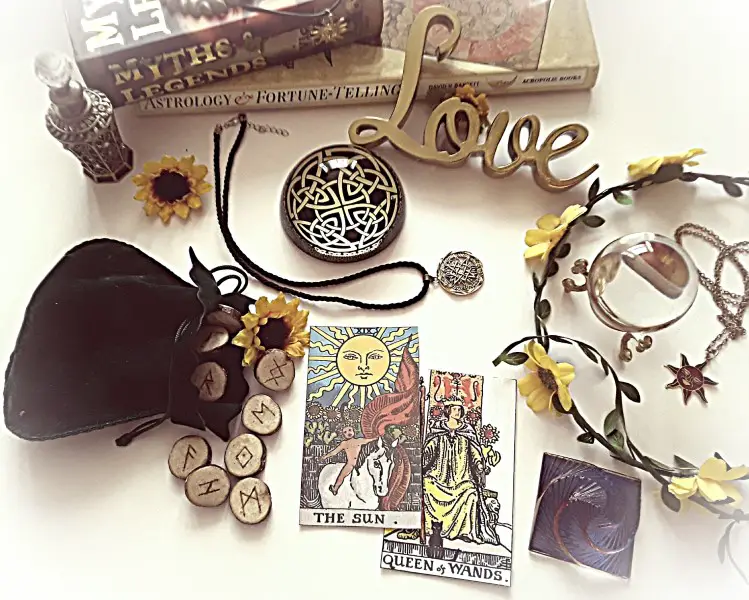
Fear of Sunflowers
I’ve written in more detail about Fear of Sunflowers here and offered ways of helping those that may suffer from this. The phobia itself is called helianthophobia.
However, to cover this in brief. Yes, this does exist. There are those that see the Sunflower as an object to be feared. There are a number of reasons why this might be the case.
Fear of the Sunflower Bloom
Some people are known to have a fear of the head of the sunflower. In some varieties, the bloom can become a large size, known to grow to sizes of 2 feet or more
The Vortex Aspect
For others, the spiraling nature of the Fibonacci sequence present in the bloom can create the sense of a vortex which may be pulling them in toward the center. For some, this can be enough to find Sunflowers disturbing to look at.
There are other interesting reasons, including the kind of ‘things’ that you find around sunflowers! Find them in my article helianthophobia here.
Where to Buy Sunflowers
There are over 70 varieties of sunflowers. We’re all familiar with tall ones, but there are multiple bloomed, dwarf and colorful ones too. Throughout the many years of growing sunflowers, I’ve gathered together the 31 most wonderful sunflowers that I love of all time
The article has charts depicting colors, heights, bloom size and whether they’re multi or single-headed. And if you can’t get the seeds locally, I’ve managed to find them all on Amazon if you wish to get them and enjoy them.
Sunflower Growing Kits
Growing kits are great for gifts, or to get yourself started growing sunflowers. They usually come with seeds, compost, a vessel to grow them in, and easy to follow instructions. They’re ideal for children or as a gift for sunflower lovers.
I’ve created a video on ‘unboxing sunflower kits’. Its shows 3 sunflower kits in different price ranges. What’s inside them and how to plant up. You can also follow the progress and how they turned out in my unboxing article here. You’ll find there have been some curious and amazing results.
If you want to start growing sunflowers or give a kit as a gift, I’ve picked 2 beautiful, sunflower kits, that I really love from Amazon below.
I chose this sunflower growing kit in a can because it’s quirky and more importantly its made from 100% recyclable material.
Sunflower Grow Kit in a Can.
This kit comes with 12 individually wrapped tiny terracotta pots and everything you need to grow sunflowers. wonderful as wedding favors and multiple gifts.
Buzzy Seeds Terra Cotta Minis 12-Pack.
My Conclusion
There’s so much information, knowledge and interesting facts about Helianthus Annuus, or the humble sunflower. We grow sunflowers because we like having these lovely plants in our garden..yards. The wonderful colors, the amazing dwarf varieties, and the majestic giants turn our neighbor’s heads and are loved by everyone.
But, Sunflowers are more than just pretty flowers. They’ve been gracing our lives for thousands of years and revered for all that time too.
Throughout the modern world and in ancient times sunflowers have been a symbol of hope, strength, happiness, enlightenment, and Peace. Religions, beliefs, and folklore hold them in high esteem. Songs, poems, masterful artwork, and inspirational quotes fill our everyday lives.
Sunflowers are used in foods, medicines, health and beauty products. They provide food and shelter for insects, birds, animals, and livestock.
Sunflowers play a big part in our ecological and economic system. And hopefully, they’ll carry on being part of our lives for thousands of years to come. Teaching us and inspiring us.
Personally, I truly hope so.

